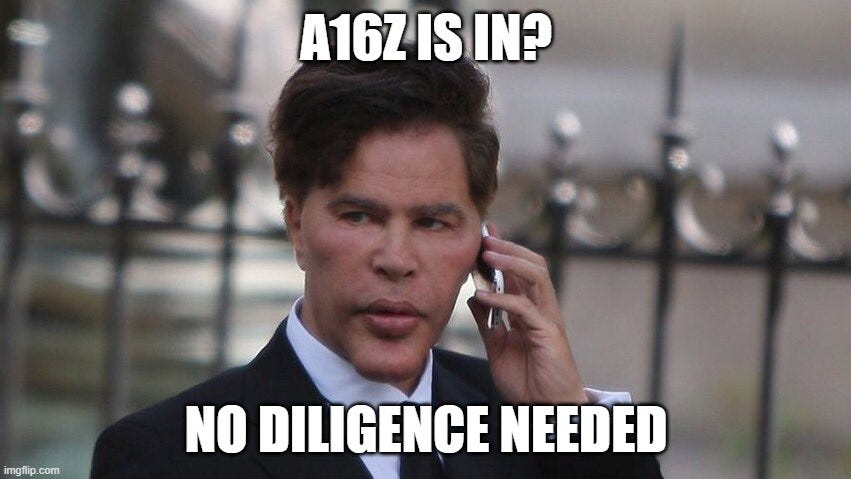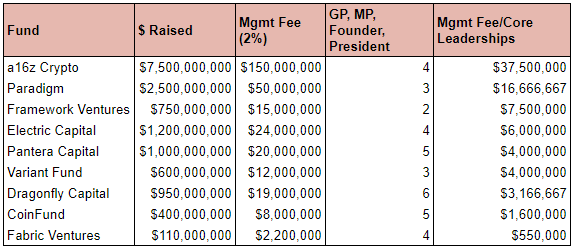Diligence on Crypto VCs
Am I adding value sir?
Disclaimer, NFA, all that legal stuff: All the information presented on this publication and its affiliates is strictly for educational purposes only. It should not be construed or taken as financial, legal, investment, or any other form of advice.
Hi folks 🙋🏻♂️,
The origin of this publication is to serve as a place to document my thoughts while hopefully providing value for others. This week’s issue can’t be further from the previous sentence. On September 28, @codygarrison_ from Clearblock released a web3 VC ranking database for founders to better understand the crypto VC landscape. I’ve always loved the idea of reverse accountability. Auditing the auditors, regulating the regulators, and doing diligence on the VCs. Clearblock did a good job providing scores for these VCs, so I’m going to focus on the financials aspect instead.
Diligence on Crypto VCs
Investors often scrutinize founders about their burn. They scream “go fast and break things” when times are good and pontificate on how to manage burn when times are tough. Although it can be rather annoying and “obvious in retrospect”, the aforementioned attitude makes sense as VC firms’ ultimate responsibility is to generate returns for their LPs. As much as we like to meme about VCs “adding value” to their portfolio company, the reality is quite tricky. There’s no perfect formula for VCs to add value. It depends on a multitude of factors such as the stages of their portfolio companies and how experienced the founders are. Younger founders might need operational help while experienced founders might prefer if you just shut up.
In this piece, I try to make sense of crypto VC funds economics. For founders or professionals that aim to work in the crypto investing landscape, it’s paramount to understand the math behind these funds to prepare for any sort of circumstances.
Sometimes, it’s a simple question: can the fund still eat if there’s no performance fee?
This is especially important if we’re about to enter a multi-year bear market. I was working for a crypto fund in 2019 and got caught off guard by how severe a crypto market downturn could be. Granted, we might not see anything as severe ever again. The crypto ecosystem has matured significantly since then and there’s a ton of capital waiting on the sideline — but; this doesn’t mean that we shouldn’t scrutinize funds just like how we scrutinize startups.
Private markets are also often opaque. Due to lesser regulations, it’s harder to find information on best practices and the standards around VC firms’ accounting. This problem is even more apparent in crypto because of two things: (1) tokens and (2) global nature. Tokens create liquidity reflexivity, enabling private market investors to be savvier with their exit strategies and the global nature of crypto means that funds can adhere to different standards around the world depending on their jurisdictions.
P.S. before you comment, I’m not advocating for more regulations, in fact, I think the accredited investor rules are extremely outdated.
Additionally, job titles on venture funds can also be quite vague. What’s a research partner? Do you get part of the carry, or are you basically a senior investment associate? @Darrenlautf did a great job cleaning up web 3 analyst compensation survey results, which are accessible here. Anyway, let’s get into it.
Here are the quick takeaways:
Private markets are often opaque, which makes it difficult to get a clear understanding of a fund’s compensation structure and financial health.
Investment DAO can lead the way in improving a fund’s transparency by storing everything on-chain.
As founders or young investment professionals, scrutinizing the VC firms themselves as a business is crucial.
The bull market gave rise to many new VC firms, which deserve more diligence as they themselves can be considered “startups” also.
VC is a “top-heavy” business — the majority of the value capture goes towards the founders and General Partners. Understanding this dynamic when one is raising capital is critical to find the best fit for your startup.
Context
I’m using Clearblock’s web3 VC database. The folks at Clearblock have aggregated a lot of good data but I’ll only be focusing on the top 50 firms whose amounts of capital raised are easily identifiable, excluding company spin-out venture arm (Coinbase Ventures, Binance Labs) and older funds as they generally haven’t raised much in the past few years and it’s much harder to distinguish between their returns from holding spot ETH since 2016 vs the returns from their more recent investments. So, I’ll be focusing my assessments on the following 9 VC firms.
Notes & assumptions:
The management fee is 2%
In reality, this will vary. It depends on the fund's NAV in the following years after launch (based on portfolio company future raises). It also depends on the specific agreements with different types of LPs. In some jurisdictions, typically EMs, the fees also tend to be slightly lower (in the 1% range) as the dynamic of the industry differs from the maturity of US financial markets.
The fund investing lifecycle is 3 years
In reality, most of these firms will most likely raise another fund before they fully distribute the returns from the current fund. It generally takes 3 years to deploy the capital and another 2 years to recoup and distribute the returns. Most reputable funds would be able to raise new funds before the 5-year lifecycle ends, bringing in more management fees to continue the operations.
# Employee: information is taken from the funds’ websites.
GP, MP, Founder, President column keeps track of the fund’s top leadership.
The most right column keeps track of the # of employees who hold top managerial positions, either “Partners” outside of GP/MP such as Research Partner, as well as Principal, Director, and any C-level executives.
I’m sure some of these numbers can be improved, but the point here is to have a starting point on how to assess these VCs. The accuracy is bound to vary as each fund has different compensation structures.
These are top-tier crypto funds and have funded Unicorn thanks to the bull market in the past two years, so I’m sure none of them will actually struggle. What I hope to showcase is how VC funds fare during market downturns.
Findings
Electric Capital has the highest management fee per employee
A VC firm can also be seen as a “start-up”, which was reflected in these numbers. For example, a16z might have the highest management fee per employee, but we haven’t considered how much of this fee goes towards the broader firm executives and founders who might not be directly involved in the a16z crypto fund operations (Marc, Ben, Margit, others). These details are not known to the public and can skew how we perceive these numbers.
Excluding a16z, the other funds here are crypto-native, making it easier to digest the numbers in an accurate manner. Electric Capital leads by having the highest management fee per employee, while Fabric Ventures has the lowest.
Pantera Capital has the highest leadership-to-employee % ratio
This number simply shows which firms have more people in leadership positions compared to the total number of employees. It can be treated as a positive or a negative depending on how you see it. For instance, Pantera Capital leads the way at 58%. On one side this can be seen as hiring enough personnel to do the work and actually support your portfolio companies. On the other side, this can also mean those leadership roles receive a smaller cut of the fees (management or carry). There was an executive exodus from Pantera a few months back. Take that with a grain of salt.
On another note, I’m positive that a16z being a non-crypto native firm has a lot more employees who are handling the operational side of the funds, that might not be listed under the a16z crypto team. This is why their number is the lowest at 10%.
a16z and Paradigm have the highest management fee per core leadership
Once again, the same context applies to a16z for being a non-crypto-native fund.
Putting that aside, based on publicly available information and subjective judgments on the leadership individuals’ titles, Paradigm leads the management fee per core leadership positions. We won’t know the exact agreement details that these firms have with their top executives who weren’t necessarily founders of the firms (hence outside of the “core leadership” classification), but it’s a start.
On-Chain Transparency
In an ideal world, we’ll have much more detailed reporting from VC funds about their compensation structure in order for founders to also do diligence on the health of the VCs that are investing in them. While the top VC firms assessed above might never have any liquidity issues, smaller firms that can go out of business because of the market downturn will be detrimental to founders. Founders will lose access to future support, and networks; and might even need to waste time dealing with secondary sales of a liquidated fund.
Alas, with the rise of many smaller crypto VC firms — if you’re a founder who needs to raise capital from these new entities, or if you’re young professional thinking of working for these funds; make sure to implement the basic models above and scrutinize the financial health of the firm. Perhaps investment DAOs can pave the way by putting all of their economics on-chain, making it verifiable for any parties who want to conduct business with the DAO, enabling others to do diligence on the entity that typically does diligence.
Being Young in Crypto
Yesterday, @knowerofmarkets, a great writer and a fun personality on crypto Twitter posted the following tweets. I’ve truly enjoyed knower’s work. In fact, his work helped reinvigorate my drive to write. So when I saw these tweets, I felt compelled to respond (or at least think internally) about what he said. Knower is young — I know this as he often talks about how he’s still in college. Being in crypto at a young age exposed one to a lot of interesting knowledge, both good and bad, and your growth depends on how you consume it. Some become “too online” and adopt an edgy libertarian incel personality while others become more thoughtful about the complexities of the world.

Crypto sits at the intersection of tech, finance, game theory, government regulations, privacy, individual liberty, and others. Getting bombarded by all of these thoughts when you’re young can be difficult. Most people aren’t able to become masters at one of those fields, let alone the intersection of all of them. Crypto also often glorified young entrepreneurs; the 18 y.o. that made $8 figures by capturing MEVs and has an anime pfp. While it’s amazing what some of these people have accomplished, we need to normalize talking about the mental toll of being in crypto. After all, an industry will only be as great as its next generation of builders.
Translation: I was drinking three nights a week in my early 20s and got rug pulled by Wanchain ICO.
Until next time,
Marco M.









